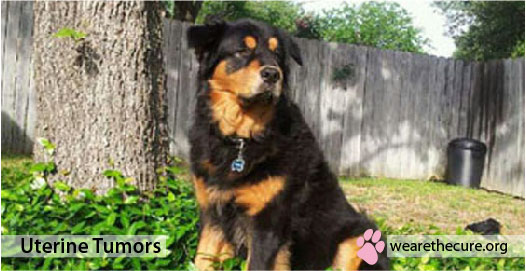Uterine Tumors
 Description – Uterine tumors consist of 0.3 to 0.4 % of all canine tumors. Leiomyomas and leiomyosarcomas are most common accounting for approximately 90% and 10% respectively. There have also been reports of adenomas, adenocarcinoma, fibromas, fibrosarcomas and lipomas. Leiomyomas are generally benign tumors. They mostly affect middle aged to older animals. However, in an incidental finding a pup as young as 10 months was found to be affected with uterine carcinoma. No breed predilection has been reported so far.
Description – Uterine tumors consist of 0.3 to 0.4 % of all canine tumors. Leiomyomas and leiomyosarcomas are most common accounting for approximately 90% and 10% respectively. There have also been reports of adenomas, adenocarcinoma, fibromas, fibrosarcomas and lipomas. Leiomyomas are generally benign tumors. They mostly affect middle aged to older animals. However, in an incidental finding a pup as young as 10 months was found to be affected with uterine carcinoma. No breed predilection has been reported so far.
Symptoms – Canine leiomyomas and leiomyosarcomas hardly present any clinical signs. They are mostly detected during necropsy (autopsy) or ovariohysterectomy (removal of the ovaries and uterus). Sometimes these tumors grow very large so as to compress the adjoining viscera (internal organs of the abdomen like the intestine, liver and pancreas). In case of both benign and malignant tumors, vaginal discharge and pyometra (caused due to hormonal and structural changes in the uterus lining) are inevitable.
Other reported clinical signs may include abdominal distension, anorexia (lack of appetite), constipation, vomiting, weight loss, lethargy, polydipsia (frequent thirst) and polyuria (urge to urinate frequently).

Diagnostic techniques – The efficacy of abdominal radiograph has been established in the diagnosis of uterine or abdominal mass. However, for a more definitive diagnosis, the surgically excised specimens are sent for histological examination. Other diagnostic work-ups may include complete blood count (CBC), biochemical profile, urine analysis, chest radiographs (x-rays), abdominal radiographs, ultrasonography and biopsy.
Treatment– Complete ovariohysterectomy is the treatment of choice for uterine tumors. The scope of chemotherapy and radiation therapy have not been properly investigated in veterinary literature.
Prognosis – The outcome for benign tumors like leiomyomas, adenomas, lipomas and fibromas is excellent. In the absence of metastasis the prognosis for malignant tumors is also good. But usually by the time they are diagnosed the disease is found to have metastasized to other organs of the body. However, the prognosis for metastatic, inoperable tumors is usually guarded.
Thank you for utilizing our Canine Cancer Library. Please help us keep this ever evolving resource as current and informative as possible with a donation.
Reference
Withrow and MacEwen’s Small Animal Clinical Oncology – Stephen J. Withrow, DVM, DACVIM (Oncology), Director, Animal Cancer Center Stuart Chair In Oncology, University Distinguished Professor, Colorado State University Fort Collins, Colorado; David M. Vail, DVM, DACVIM (Oncology), Professor of Oncology, Director of Clinical Research, School of Veterinary Medicine University of Wisconsin-Madison Madison, Wisconsin
Other Articles of Interest:
Blog: How To Help Pay For Your Dog Cancer Treatment Cost: 7 Fundraising Ideas
Blog: What Are Good Tumor Margins in Dogs and Why Are They Important?
Blog: Dispelling the Myths and Misconceptions About Canine Cancer Treatment
Blog: Financial Support for Your Dog’s Fight to Beat Cancer
Blog: Cancer Does Not Necessarily Mean A Death Sentence
Blog: What To Do When Your Dog Is Facing A Cancer Diagnosis – Information Overload
Blog: Dog Cancer Warning Signs: Help! I Found a Lump on My Dog

Recent Comments